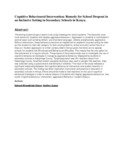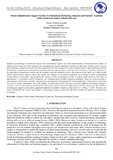| dc.contributor.author | Opiyo, Atieno Rose | |
| dc.date.accessioned | 2024-04-30T13:33:36Z | |
| dc.date.available | 2024-04-30T13:33:36Z | |
| dc.date.issued | 2023-03-04 | |
| dc.identifier.uri | https://doi.org/10.1007/978-3-031-04504-2_34 | |
| dc.identifier.uri | https://link.springer.com/chapter/10.1007/978-3-031-04504-2_34 | |
| dc.identifier.uri | http://ir-library.mmust.ac.ke:8080/xmlui/handle/123456789/2823 | |
| dc.description.abstract | Background: Short-term psychosocial problems are common among school-age developing children, emanating either from individual child characteristics and/or factors within the school setting. Essentially, these problems reduce a child’s chance for school adjustment and overall school success. Children who stutter may be at the highest risk of social adjustment difficulties and school failure when they find themselves in a non-empathetic school environment. Although there is anecdotal evidence about the adverse effects of disfluency, elsewhere, little systematic research has examined the psychosocial and academic challenges of disfluency within African school setups. This chapter explores prevalence, psychosocial effects, and coping strategies of children who stutter in Kakamega Municipality, Kenya. Methodology: Based on a qualitative approach, a retrospective analysis of school psychosocial experiences linked to disfluency was documented. Qualitative interviews were conducted with 11 disfluent pupils and their 22 non-stuttering peers aged 8–14 years and five teachers from one public primary school. Qualitative data were coded, thematically categorized, and analyzed in descriptive and narrative forms. Results: Disfluent pupils reported negative intra- and interpersonal adjustment difficulties as a result of bullying, teasing, rejection, ridicule, exclusion, low peer acceptance, shame, anxiety, anger, and loneliness. Psychological problems are a manifestation of their inability to communicate competently, difficulties in making friendships, and self-condemnation. Discussion: In response to the high incidence of psychosocial and academic challenges experienced by disfluent pupils, this chapter reiterates the need for awareness and sensitization programs to create a more empathetic school climate where differences are tolerated rather than assaulted. | en_US |
| dc.language.iso | en | en_US |
| dc.publisher | Handbook of Speech-Language Therapy in Sub-Saharan Africa | en_US |
| dc.subject | Stuttering’s, Hidden Side, Need, Empathetic, School, Climate, Disfluent, School-Age, Children, Public, Primary, Schools | en_US |
| dc.title | Stuttering’s Hidden Side: The Need for an Empathetic School Climate for Disfluent School-Age Children in Public Primary Schools in Kakamega, Kenya | en_US |
| dc.type | Article | en_US |



